T
he Optimist, the perfect boat to introduce young athletes to an ancient sport that is fun and always in harmony with nature. In this short guide we will share valuable tips, derived from years of experience in sailing competitions, for all those who wish to approach the fascinating universe of racing. Together we will explore the history and the main characteristics of the Optimist, the first boat that a young sailor can use to sail.
We will guide you through the excitement of a regatta, the strategies to adopt and the fun that this sport offers young participants.
We will take a journey through the different sailboats that accompany the growth of an athlete, all the way to monotype sailing classes such as the exciting RS21, a fast and super fun sailboat!
Finally, we will not forget the eco-sustainable aspect that characterises this sport and how, through a simple sporting activity, we can educate young people about sensitivity and care for our beloved planet.
The Optimist as a first boat
The Optimist is one of the first boats that children use to approach this sport. Before that there are the group dinghies, in which an instructor explains the ABCs of sailing to the little ones. But once the children have mastered the basics, they steer the small dinghy on their own. And that is the moment when the child is put on board the Optimist, the sailing dinghy par excellence suitable for children aged 6 to 16. Sailing on dinghies is a sporting activity that requires skill and athleticism. One can take up the sport at any age, but it generally starts when one is a child. At the age of 6 a child can enrol in a sailing school. We recommend enrolling in a school that is member of the Federazione Italiana Vela (Italian Sailing Federation) as they are a guarantee of quality thanks to the instructor’s training and the use of up-to-date nautical and teaching aids and equipment.
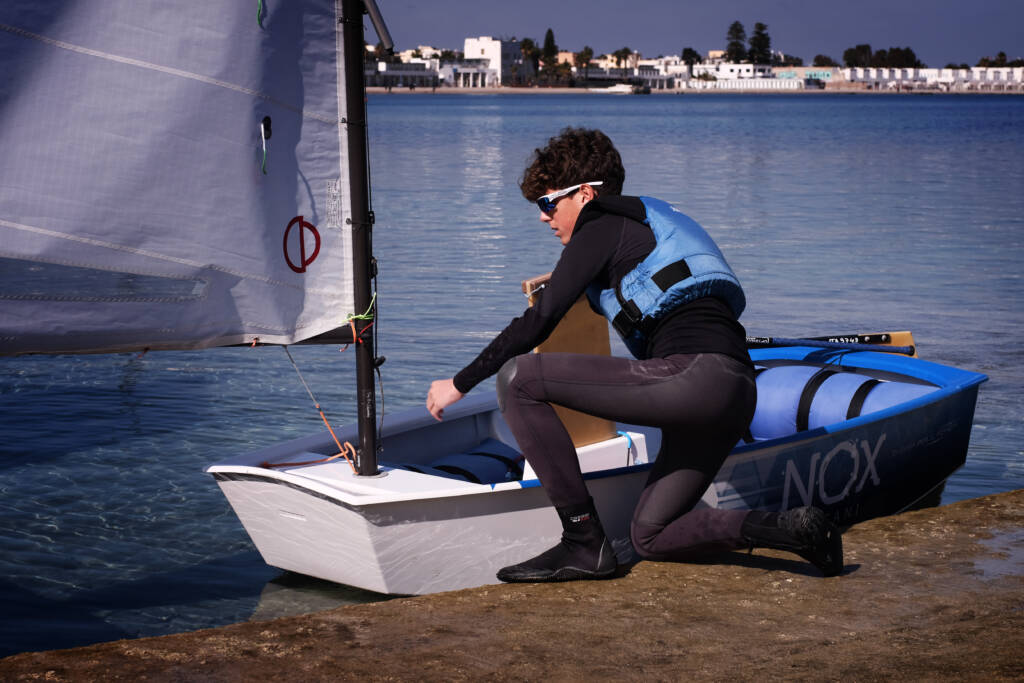
Preparing for the regatta in the sailing school
The child who starts at the sailing school will find himself in the company of many other children, some already familiar with sailing, with who he can make friends. The day unfolds with the instructor’s welcome, the roll call and then the actual lesson, where each day brings a step forward in learning. You will discover what the nomenclature is, all the parts of the boat have a specific name. You learn to speak in nautical terms, you find out what a helm is and what it is used for, then the centreboard, the sails, why a boat can go upwind. The points of sail, the different winds, and some hints of meteorology. This is how the training of the young sailors begins.
The sailing school generally starts at the end of the school year, i.e., in June, and lasts until the end of August, beginning of September. Pupils are provided with a life jacket, but it is a good idea to equip the children with a snack, a towel, sailing gloves and a water bottle when taking them to the sailing school. A cap, sunglasses and light boat shoes are indispensable. Clothing is completed with a t-shirt and swimming shorts. There will be one instructor for every 10 children in the water to ensure that each pupil is well looked after and for reasons of maximum safety.
Sailing is especially good for young children because it teaches them to tackle problems, manage a boat and, above all, have direct contact with nature and the sea. Sailing does not pollute and, considering that the sea is where the children practice this sport, it teaches them to keep it clean and respect it.
The perfect dinghy for young novice sailors
This small boat is an American design from 1947 which, thanks to its simple construction and excellent handling and manoeuvrability, has spread throughout the world to become the most popular and famous of dinghies. Even today, the Optimist is still a modern boat, ideal for learning to sail. It is a very technical boat where the youngest must refine their skills to the maximum. The shape of the Optimist is square with an overall length of 2.30 meters and a weight of 35 kg. The aluminium mast holds a trapezoidal sail with an area of 3.25 m². It is from the Optimist that one takes the first steps towards becoming a successful skipper.
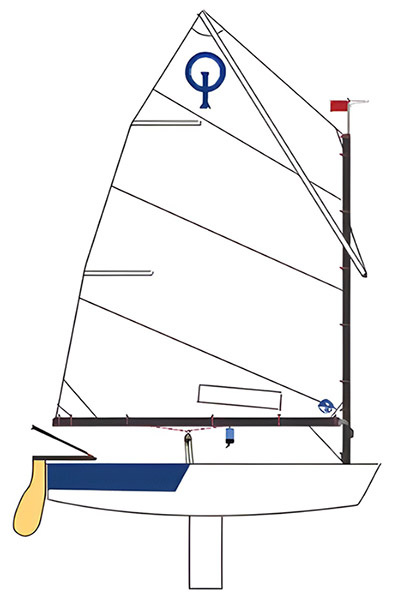
The first sailing regatta: strategy to win and have fun
A sailing regatta is a sporting competition whose objective is to sail a predetermined course as fast as possible. The skippers’ skill consists of taking into consideration all the external factors such as wind, sea and currents to use them in their favour and beat their opponents. Therefore, it is important, before each race, to think about what strategy to put into action. For those who take part in the race, the strategy is to decide the best route to take in order to be as fast as possible on the racing course. Indeed, the shortest route is not always the fastest. But in a regatta you are not alone and there will be other skippers aboard other boats on the same race course. Therefore, it is important to be able to implement the decided strategy based on the tactical choices of the moment. Tactics, in fact, is trying to apply the chosen strategy while trying to get away from the other boats.
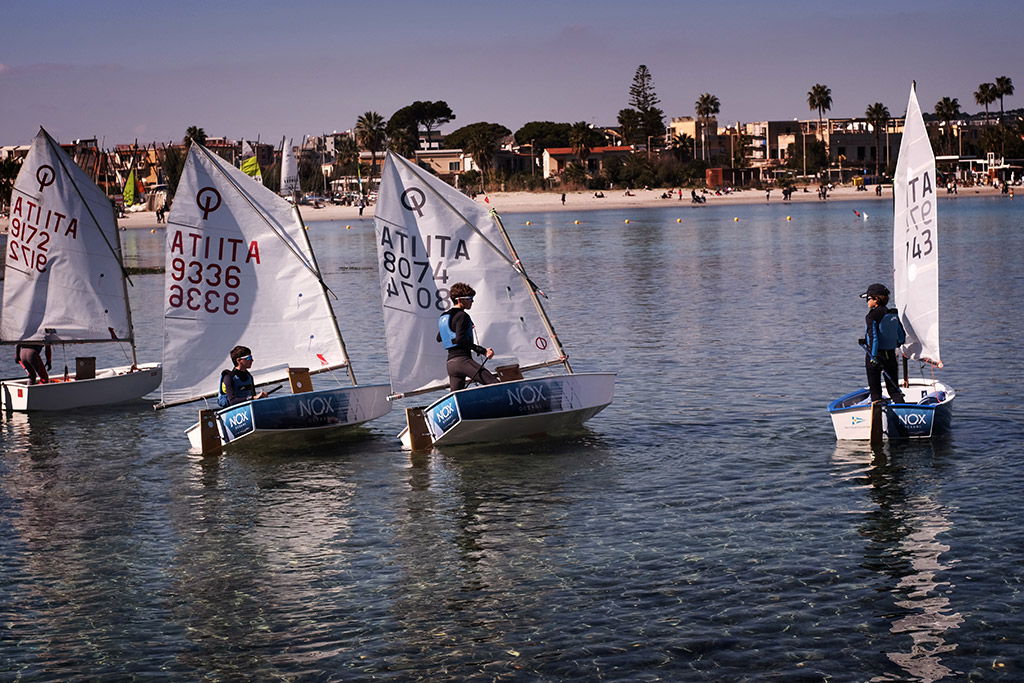
Growing up with the sailboat models
The best sailboat to start with is definitely the Optimist, but as a child grows up, he or she needs other stimuli and better performing, and above all, bigger boats. Let’s take a look at some sailboat models that ensure that the young sailor has as much fun as possible for as long as possible.
The Laser: the challenge for more experienced young sailors
Once a young sailor reaches the age limit beyond which they can no longer race with the Optimist, or if for physical reasons they are too big to stay on board, they move on to another sailing class. One of the best choices is certainly the Laser, a 4.2 metre dinghy with a single sail and a decomposable mast. What makes this boat so interesting is its international spread and, mainly, the fact that it is an Olympic class, both for men and women. The Laser is available with three different types of sails to choose from according to one’s weight and needs.
Laser Standard, with a 7.06 m² mainsail;
Laser Radial, in which the lower part of the mast varies and consequently the sail area is 5.7 m² (15 % smaller than on the Standard);
Laser 4.7, in which the lower part of the mast varies and the sail measures 4.7 m². It is usually an intermediate step before going aboard the Laser Radial and Laser Standard. The sail of the Laser 4.7 is easily recognisable thanks to its smaller size compared to the others and by the inscription “4.7” located below the sail number and nationality.
While we are still used to calling it Laser, for the recording it should be mentioned that since 1 January 2020 the class has changed its name to ILCA (International Laser Class Association).

The 29er: the racing boat for young sailors with team spirit
Not everybody switches from the Optimist to the Laser. You can make a different choice and start the adventure in doubles, i.e. sailing on board a boat in a crew, in this case of two people. The 29er is a very fast and acrobatic dinghy, so much so that it has practically replaced the old 420. The boat measures 4.45 metres, weighs 75 kg, and is equipped with a mainsail, jib and gennaker for exciting performance. On board the two crew members must share the tasks. One will be the helmsman whose job it is to steer the boat and to establish the best tactics for the start, the other will be the bowman who is in charge of setting the sails and the gennaker. He also balances the weight with the trapeze. The 29er is a high-performance boat, planing both close-hauled and on a reach from 6/7 knots. In medium and strong winds, on reach it reaches higher speeds than those of the wind.
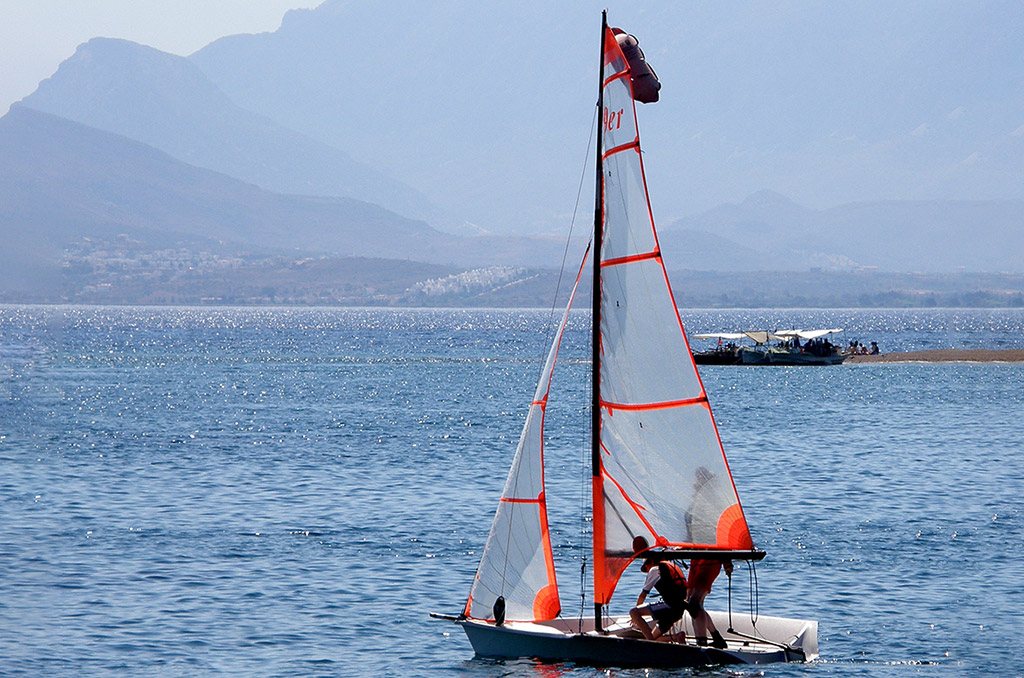
The 49er: the racing boat for young sailors in search of strong emotions
The next step up from the 29er is undoubtedly its big brother, the 49er. This is a revolutionary and high-performance two-person dinghy, with a length of 5 metres and a total sail area of 21.2 m². It is a highly sailable boat, rigged with a square-top mainsail, and is one of the International Classes listed by the international sailing federation World Sailing. The 49er races are part of the Olympic programme. The hull is planing and self-emptying with trapezes for both the helmsman and the bowman and adjustable wings. These features make it very fast and spectacular, so much so that it is the fastest single-hulled two-person dinghy there is.
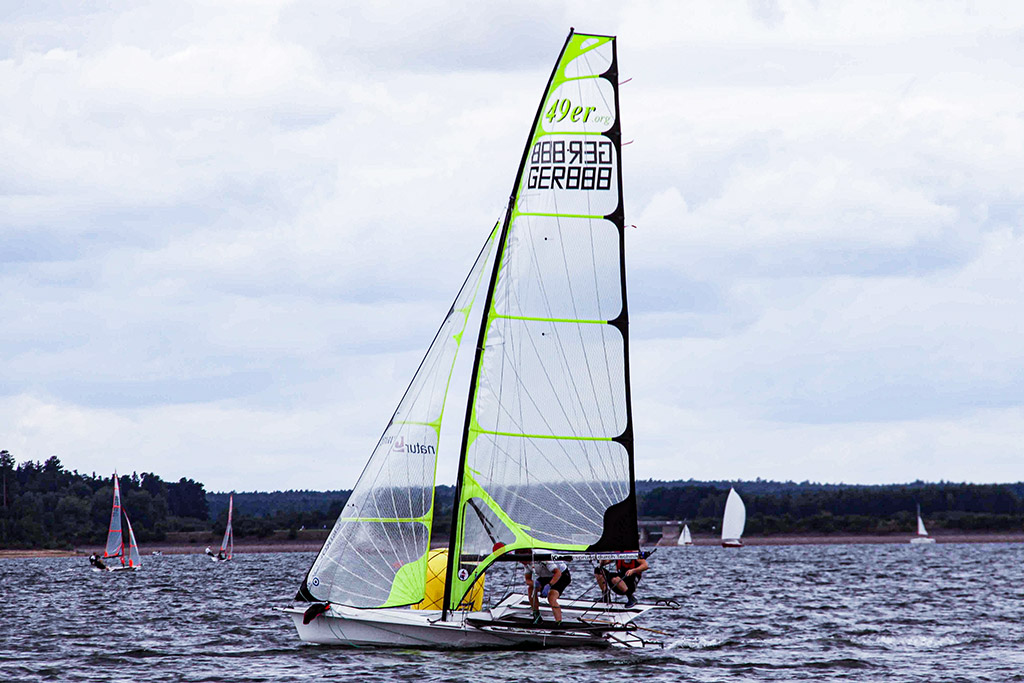
The new racing experience with the RS21: performance and fun for young sailors
Once a young sailor has outgrown dinghies, but is not yet too big for planing at 20 knots, he or she can turn to keelboats, such as the exciting RS21. This sailboat, which has become extremely popular in recent years, is a high-performative but easy to steer sportboat. The RS21 is 6.67 metres long and 2.2 metres wide, built by the British shipyard RS Sailing, the world’s largest builder of dinghies. One of the positive features of this new boat certainly is its “green” soul as it is built with eco-sustainable materials. Furthermore, it is easy to handle, can be transported with any car and fits on a cart thanks to its retractable keel.
During a race it is manoeuvred with a crew of four or five people that sit facing inwards, which means that its easy even for those who are not very athletic. Coming back to the “green” aspect, to get in and out of the harbour the boat can be equipped with an ePropulsion electric motor.
Today, the RS21 is the sport one-design of reference, so much so that owners have organized themselves in an international class association, with professionals and amateur crews competing against each other in championships around the world.
A sport and its history: discover the world of sailing regattas
The history of competitions between sailboats immediately brings to mind the America’s Cup, the first international competition born in 1851. It is certainly the highest ambition of every young sailor to one day be part of an America’s Cup team. These are goals that can be achieved with a lot of effort and by starting out on this path as a child. After attending the summer sailing school at one of the clubs affiliated to the FIV (Italian Sailing Federation), students who have reached the age of 8 and wish to continue sailing can do so by enrolling in the pre-competition course. This is the first step towards the world of regattas and it takes place from September to May. The course takes place in the afternoon and may consist of one to three outings a week with the instructor. The aim is to prepare the student to go out on their own, solve small problems that arise, sail and do manoeuvres such as tacking and gybing.
During pre-competitive racing, one starts to interpret the race course with the first rules and precedences at sea, learns how to turn the buoys and does the starting exercises. Once the student is ready, he or she can move on to the competitive team and start the first Optmist regattas as per the FIV calendar.
Sail into a sustainable future by practising the sport of sailing
The sport of sailing only requires wind (and a boat, of course!), which makes it one of the most environmentally sustainable sports. It is surely one of most sustainable and nature-friendly sports. While sailing you are in very close contact with nature and its elements. You often come across a group of dolphins swimming around the sailboat as they are not disturbed by articifial noises such as the engine. This is where we learn to respect the sea and nature. We are guests in an element that is not naturally ours, but thanks to the sailboat we have the opportunity to enjoy it without producing pollution.
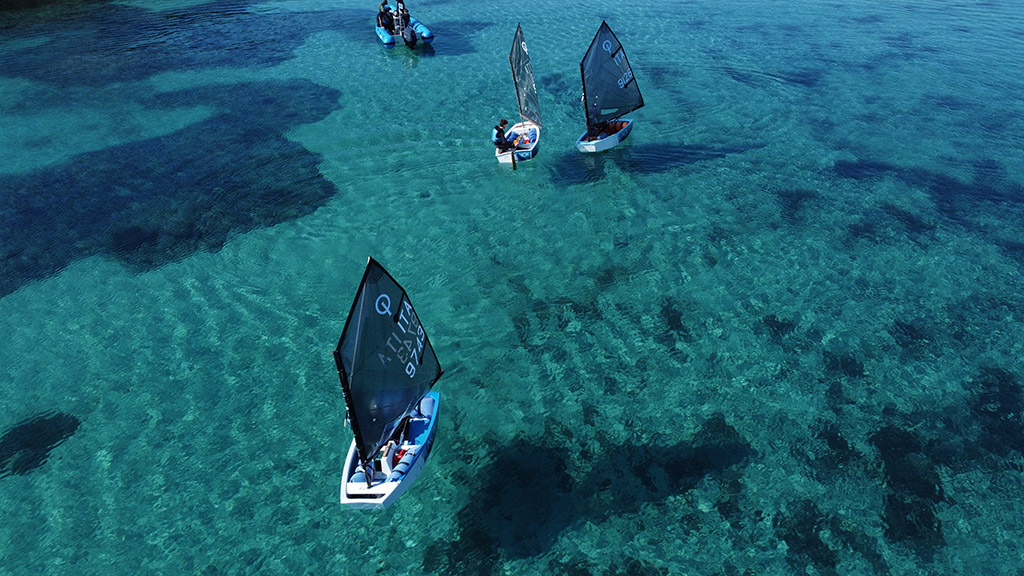
Sports clubs as Blue Influencers
The eco-sustainability of this sport has led sports clubs to become true Blue Influencers. In fact, by attracting sponsors and companies to them, they make their teams ambassadors of the principles of environmental sustainability. This principle embraces the current trend: sustainable economy.
Which sport makes its team become a flagship of a cultural movement?
How youth sailing contributes to the circular economy: projects and initiatives
It is precisely Nox Oceani that is one of the first teams to embrace the circular economy and campaign for the principles of eco-sustainability. The Nox Oceani team is very active in most international competitions, centralising sponsors that believe in the values of eco-sustainability and are looking to the Blue Influencer as a new way to pursue sustainable investments and be one of the socially relevant companies and in line with the 2030 and 2050 Agenda.
Become a successful young sailor: choose your path and have fun racing
As mentioned, the first approach to sailing is on dinghies. To become a successful young sailor, it is therefore necessary to enrol in a sailing school and take all the steps that will lead to competing in the first fleet races. It will be easy to find the right path, thanks also to the qualified FIV instructors who can give the best guidance. After the Optimist, in fact, one can continue in singles on the Laser or the RS Aero or one can approach a dinghy in doubles. This is also due to the fact that some sailors are more inclined to play a technical role such as bowman, while others will continue to steer the boat at the helm.
Conclusion
Whatever path you choose to take, if you start from the Optimist or wait until you are older and experience the thrill of the RS21, the important thing is that you have fun. In this sport fun and contact with nature must be the motive to become more conscious teenagers with a keen eye for the planet.
We have seen the sailboat, but racing in general is a sport that, especially in Italy, has a history rich of technology and important people.
Nox Oceani tries to make this sport a social commitment, but we will never tire of repeating it: the values we pursue are fun, mutual respect and a lot of wind to tame!
